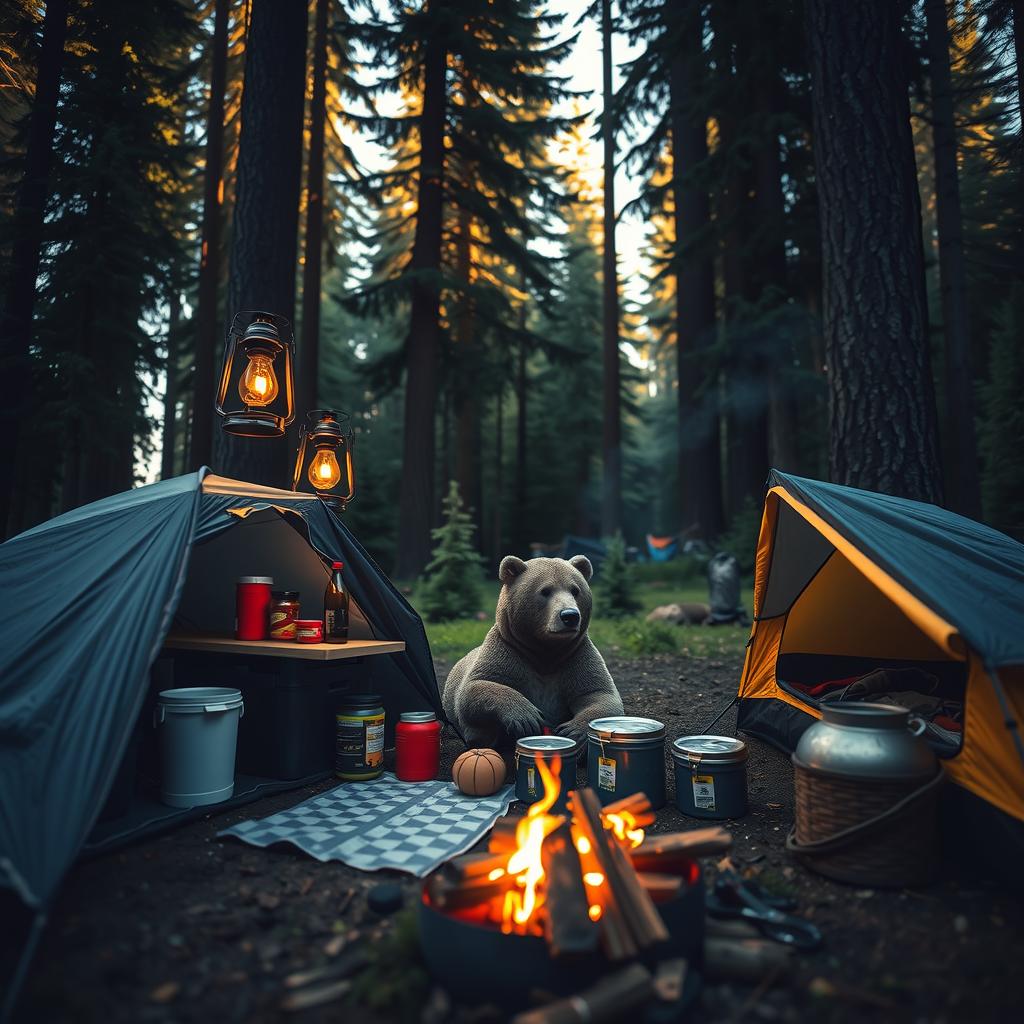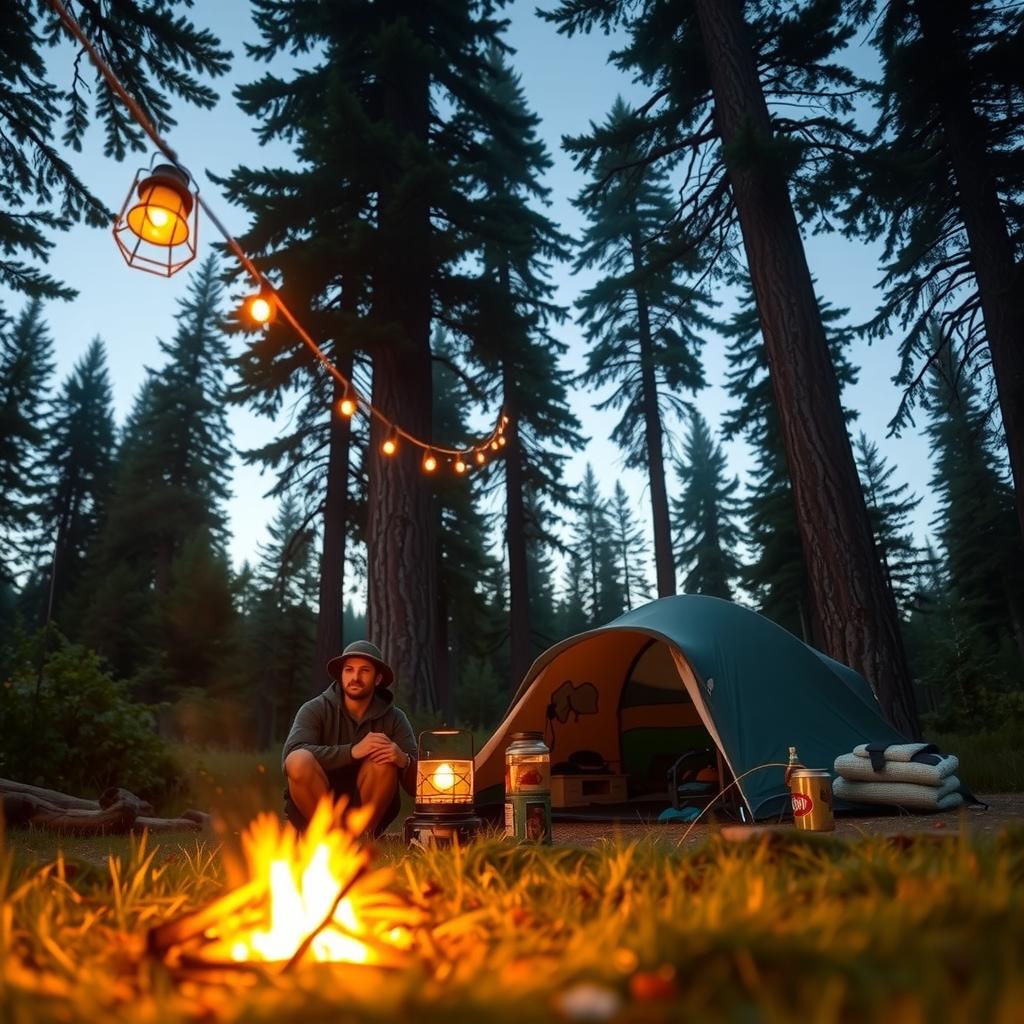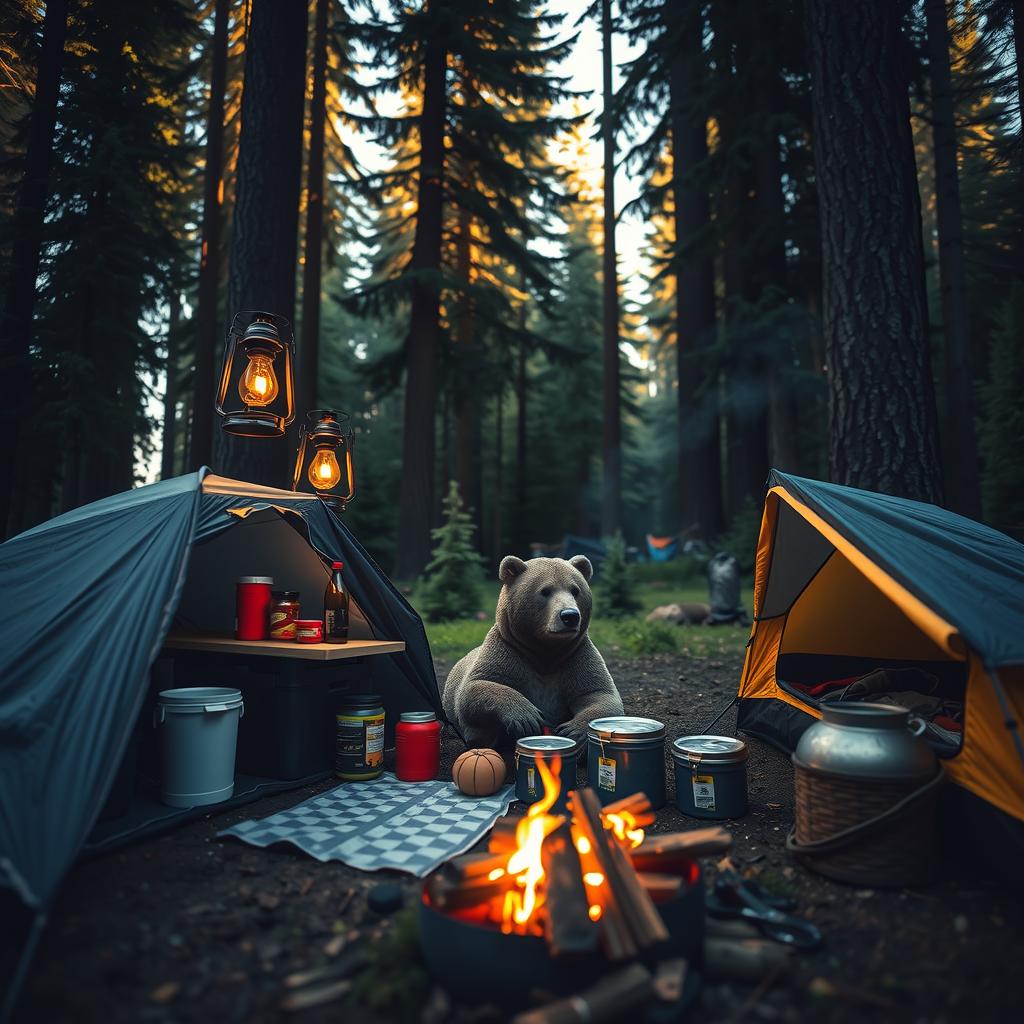When planning an unforgettable camping trip in bear country, the thrill of nature often comes hand-in-hand with the reality of potential dangers lurking nearby. Imagine waking up to find that a curious bear has rummaged through your food supplies overnight, turning your peaceful retreat into a chaotic scramble for safety. This scenario is not just possible; it’s all too common among outdoor enthusiasts who underestimate the importance of proper camping food storage. As captivating as these wild landscapes can be, they are also home to wildlife that thrives on human provisions. Understanding and adhering to bear country safety guidelines is essential for anyone venturing into these territories.
The core value of this article lies in its commitment to ensuring a safe and enjoyable outdoor experience by providing crucial food safety guidelines specifically tailored for campers in bear-prone areas. From understanding how bears perceive their environment to implementing effective wildlife prevention measures, this piece aims to equip readers with indispensable knowledge about responsible camping practices. By exploring practical solutions like utilizing bear-proof containers and adopting smart food storage solutions, campers can significantly reduce the risks associated with attracting wildlife.
Transitioning seamlessly from concern to action, this article will delve into best practices for storing food while camping safely amidst nature’s fiercest inhabitants. Readers will discover expert tips on organizing meals efficiently without compromising safety or convenience—after all, enjoying delicious meals around the campfire shouldn’t come at the expense of tranquility or security! With insights grounded in real-world experiences and supported by proven techniques for outdoor cooking, those preparing for adventures in bear territory can confidently embrace their time outdoors while prioritizing both enjoyment and protection.
In summary, whether one is a seasoned camper or embarking on their first wilderness adventure, understanding how to navigate camping best practices related to food storage is paramount. The following sections will elucidate strategies that not only safeguard personal belongings but also promote harmony between humans and wildlife—a goal every responsible outdoor lover should strive toward as they explore our magnificent natural world.

Key Insights:
-
Understanding Bear-Proof Containers: These specialized tools are essential for effective camping food storage in bear country. They not only protect your food from being accessed by bears but also play a significant role in wildlife prevention. Utilizing high-quality bear-proof containers can ensure that meals remain secure, allowing campers to enjoy the wilderness without unnecessary risks.
-
Implementing Smart Packing Techniques: Proper packing is crucial when it comes to food safety guidelines. By segmenting food items and using odor-proof bags, campers can minimize scents that may attract wildlife. It’s advisable to store all cooking equipment and leftover food away from sleeping areas, ideally in designated storage solutions designed for outdoor adventures. This proactive approach enhances overall bear country safety while facilitating a more enjoyable camping experience.
-
Adopting Best Practices for Outdoor Cooking: Following established camping best practices, such as cooking during daylight hours and cleaning up promptly after meals, is vital for reducing encounters with bears. Utilizing portable stoves instead of open campfires can further decrease the likelihood of attracting wildlife through lingering odors. By embracing these practical outdoor cooking tips, campers ensure both their personal safety and the well-being of local animals, fostering a harmonious relationship with nature.

The Necessity of Food Storage in Bear Country
Protecting Nature and Ensuring Safety
In bear country, understanding the significance of proper food storage is paramount for both personal safety and wildlife preservation. When individuals venture into these natural habitats, they must recognize that bears possess an extraordinary sense of smell—up to seven times greater than a bloodhound’s. This remarkable olfactory ability means that any scent emitted from improperly stored food can attract bears from significant distances. Hence, adhering to food safety guidelines is not merely a precaution; it is an essential practice in preventing unwanted encounters with these magnificent creatures. Campers should invest in bear-proof containers, which are designed specifically to withstand a bear’s attempts at accessing their contents. These containers are often made with durable materials and feature locking mechanisms that thwart even the most determined wildlife.
Moreover, beyond just storing food correctly, campers also need to consider the broader implications of their activities on local ecosystems. Bear encounters typically arise when humans fail to follow established camping best practices, such as cooking away from sleeping areas or cleaning up thoroughly after meals. Adopting effective outdoor cooking tips can significantly reduce risks associated with attracting bears while enjoying nature’s bounty. For instance, utilizing designated cooking areas and ensuring all waste is secured can help mitigate potential threats effectively while maintaining the integrity of one’s camping experience.
Strategies for Effective Wildlife Prevention
Practical Solutions for Camping Safety
Utilizing effective strategies for food storage plays a crucial role in promoting safety within bear country and contributing positively toward wildlife management efforts overall. Implementing practical solutions such as hanging food bags high or using specialized suspension systems ensures that edibles remain out of reach from curious animals searching for easy meals during their nightly prowls through campgrounds. Additionally, understanding how different seasons affect bear behavior helps inform better practices tailored specifically towards varying conditions; during springtime when bears emerge hungry after hibernation or late summer when they prepare for winter by seeking abundant calorie sources.
Engaging with fellow outdoor enthusiasts about shared experiences regarding food storage solutions fosters community awareness surrounding responsible camping habits too! Through open conversations centered around challenges faced while navigating wild terrains come innovative ideas worth exploring together—a testament reflecting nature lovers’ commitment not only towards individual safety but also respect towards preserving wilderness environments where these animals thrive uninterruptedly amidst our adventures outdoors.
Ultimately, embracing comprehensive measures concerning proper food storage will result in safer experiences whilst simultaneously safeguarding precious ecosystems reliant upon harmonious coexistence amongst all living beings sharing this beautiful planet we call home!
Best Practices for Camping Food Safety
Essential Tips for Managing Food Supplies in Bear Habitats
When camping in bear country, understanding food safety guidelines is crucial to ensure both personal safety and the well-being of wildlife. Proper management of food supplies can significantly reduce the risk of attracting bears, which is essential for a safe outdoor experience. One key strategy involves utilizing bear-proof containers, designed specifically to keep food out of reach from curious bears. These containers are robust and often certified by wildlife agencies, making them an indispensable part of any camper’s gear when venturing into areas known for bear activity. Additionally, it’s vital to store all food items—including cooking utensils and trash—in these secure containers whenever they are not in use.
The location where food is stored also plays a critical role in camping food storage practices. Campers should position their cooking area at least 200 feet away from sleeping quarters to minimize scent trails leading back to tents or vehicles. Furthermore, employing effective wildlife prevention tactics such as using strong-smelling foods sparingly can make a significant difference; opting for low-odor meals helps decrease the likelihood that bears will be drawn towards camp sites. For those planning on preparing meals outdoors, following proper outdoor cooking tips is essential—cooking during daylight hours reduces risks associated with nighttime encounters with bears while ensuring all leftovers are packed away securely after each meal.
In addition to securing your provisions, maintaining cleanliness around the camp is paramount; this includes wiping down surfaces used during meal preparation and promptly disposing of waste in designated bins or secured bags until they can be placed inside bear-proof receptacles. Consideration should also be given to how long perishable items remain unrefrigerated—the USDA recommends consuming these within two hours if temperatures exceed 90°F (32°C) or one hour above 100°F (38°C). By adhering strictly to these conscientious approaches towards managing food supplies in bear habitats—like investing time into learning about effective food storage solutions—campers contribute greatly not only to their own safety but also assist in protecting local wildlife populations.
Overall, integrating these best practices ensures that campers enjoy their wilderness experiences without incident while respecting nature’s delicate balance. With meticulous attention paid toward managing potential attractants effectively through informed choices regarding container usage and site organization based on established protocols concerning human-bear interactions found within various regions’ guidelines—a successful camping trip awaits those willing to engage thoughtfully with their environment.
Essential Tools for Safe Outdoor Food Storage
Protecting Your Camping Experience from Wildlife Encounters
For outdoor enthusiasts, ensuring food safety is paramount, especially when venturing into bear country. The right camping food storage solutions can significantly reduce the risk of attracting wildlife and enhance the overall camping experience. One effective strategy involves using specialized bear-proof containers, which are designed to withstand even the most determined wildlife attempts to access stored food. These robust units not only provide a secure environment for perishable items but also adhere to strict food safety guidelines that are crucial in bear-populated areas. Properly utilizing these containers includes understanding their locking mechanisms and placement; it’s essential to store them at least 100 yards away from sleeping areas while keeping them elevated or anchored if possible.
In addition to bear-proof containers, various packing methods play a vital role in maintaining food safety during outdoor adventures. Utilizing resealable bags can minimize odors emanating from meals while also categorizing different types of foods effectively, helping campers find what they need quickly without rummaging through their supplies unnecessarily. Moreover, adopting smart outdoor cooking tips, such as preparing meals ahead of time and vacuum-sealing them before departure, will not only save space but ensure freshness when it’s time to eat under the stars.
Wildlife Prevention Techniques for Campers
Strategies That Enhance Safety While Enjoying Nature
To further bolster protection against wildlife encounters during camping trips, implementing thoughtful strategies surrounding food storage is key. Understanding local animal behavior helps inform best practices and encourages campers to respect nature’s boundaries by minimizing human impact on wildlife habitats. For example, storing trash properly in dedicated bins with tightly sealed lids prevents animals from being drawn too close to campsites—a common practice that many seasoned adventurers endorse as part of their commitment toward responsible camping ethics.
Additionally, engaging in discussions about potential threats—such as how bears react around human presence—can empower groups with knowledge regarding proper responses if an encounter occurs despite precautions taken. This shared awareness fosters a sense of community among fellow campers who aim for sustainable enjoyment within natural landscapes while actively participating in wildlife prevention measures essential for long-term preservation efforts.
Mastering Camping Best Practices
Elevate Your Adventure with Smart Food Management
Ultimately, mastering effective food storage solutions translates into enriching experiences outdoors where individuals can enjoy nature uninhibited by fears surrounding unwanted animal interactions or compromised meal quality due to improper storage techniques used throughout excursions into wild terrains inhabited by diverse ecosystems—including those frequented by bears! By integrating both innovative products like high-quality bear-resistant gear alongside tried-and-true traditional methods rooted deeply within successful historical practices—campers equip themselves with tools necessary not just survive travels but thrive amidst breathtaking scenic vistas brimming energy eager explorers seek out year after year! Thus embracing comprehensive approaches toward safe eating habits maximizes pleasure derived while traversing beautifully rugged landscapes filled adventure awaits discovery around every corner encountered along paths less traveled together!
Frequently Asked Questions:
Q: What are the most effective food storage solutions for camping in bear country?
A: When camping in bear country, using specialized bear-proof containers is crucial. These containers are designed to withstand a bear’s attempts to access food and can significantly reduce the risk of attracting wildlife. Additionally, storing food at least 100 yards away from sleeping areas and cooking sites helps maintain a safe distance between humans and bears.
Q: How can campers ensure their cooking remains safe from wildlife encounters?
A: Implementing proper food safety guidelines is essential for outdoor cooking. This includes preparing meals that require minimal cleanup, keeping all utensils clean, and promptly disposing of waste in designated trash bags or bins specifically designed for wildlife prevention. Using resealable bags or airtight containers also aids in keeping scents contained while ensuring that no accidental spills occur during meal preparation.
Q: Are there any specific camping best practices I should follow regarding food storage?
A: Yes! Following established camping best practices will enhance both safety and enjoyment during your trip. Always choose high-quality bear-proof containers when packing your supplies; these products not only deter bears but also keep your food fresh longer. Moreover, consider utilizing hanging systems or lockers provided by campsites as additional precautions against unwanted animal visitors while ensuring a seamless experience with your outdoor cooking tips.

